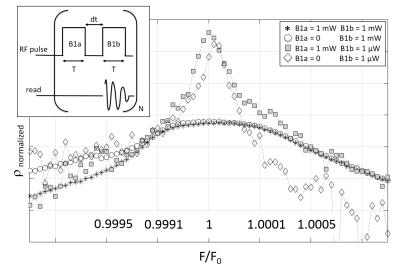2704
Reducing the screening during transmission using non-linear properties of high sensitivity superconductor radiofrequency coils for magnetic resonance micro imaging1Unité Mixte de Physique, CNRS, Thales, Univ. Paris-Sud, Université Paris-Saclay, Palaiseau, France, 2Laboratoire d’Imagerie par Résonance Magnétique Médicale et Multi-Modalités (IR4M), UMR8081, CNRS, Université Paris-Sud, Université Paris Saclay, Orsay, France, 3Laboratoire des Solides Irradiés, CNRS UMR 7642 & CEA/DSM/IRAMIS, Ecole Polytechnique, Palaiseau, France, 4Aix-Marseille Univ, CNRS, CRMBM UMR 7339, Marseille, France
Synopsis
In MRI, high-temperature superconducting (HTS) radio frequency (RF) coils have been shown to greatly improve the signal-to-noise ratio. The nonlinear behavior of superconducting materials as a function of the emitted RF power is, nowadays, one of the principal technological obstacle limiting the use of these materials on a wider scale. It could be overcome by using HTS coil in reception mode only. Here we characterize these non-linear properties and use them to decouple the HTS coil during transmit mode. This preliminary study is a promising approach to use the highly sensitive HTS coils in reception mode only.
Introduction
High-temperature
superconducting (HTS) radio frequency (RF) coil has proven their potential to
improve the sensitivity of the Nuclear Magnetic Resonance signal detection1.
However, the non-linear behavior of superconducting materials as a function of
the transmitted RF power remains, nowadays, one of the principal technological limitation
for a wider use since it would results in coil-transmitter mismatching,
misadjustment of the flip angle, and shape distortion of slice-selective soft
pulses2. Such drawbacks could be avoided by using HTS coil during the reception step only and use a classic copper
coil for transmission. This requires to decouple HTS coil during transmission
mode, which is difficult to perform considering their high quality factor. Here,
we charactarize the behavior of reduced
critical currents RF HTS coils with different transmit power levels. It is
shown that the screening at high power can be reduced significantly suggesting
that HTS receive coils can be intrinsically decoupled during transmission by
making use of superconductive non-linearity and adequate critical current
scaling
Materials and Methods
HTS 12 mm diameter multiturn transmission line
resonators3 were characterized at 77 K. Their HTS material properties were slightly modified
to increase critical current density to a point where electromagnetic fields all but
penetrate the HTS coil. HTS coils were inductively matched using a 10 mm
diameter copper loop tuned at the HTS coil frequency F0. The
low-power swept-frequency analysis and high-power measurements4 were
done in a pulsed mode with a multireceiver MR console Tecmag Apollo Houston,
TX, and a −40 dB dual-directional coupler. The RF pulses, described in the figure
2 had a rectangular shape with time Ta and Tb with a repetition time TR and an amplitude B1a and B1b respectively. The
reflection coefficient ρ, defined from the incident and reflected powers, were systematically
extracted from each measurement. Experiment 1 reproduced a swept-frequency
analysis classically performed with a vector network analyzer (T = 1.8 msec,
B1a = 0, B1b varied from 1µW to 1mW). Experiment 2 reproduced
an NMR sequence (pulse a – excitation pulse, pulse b - simulating the NRM
signal reception with T = 1.8 msec and dt = 100 µs).Results and Discussion
Figure 1 illustrated the effect of the power level (1µW figure 1a, 1mW figure 1b) on both resonators. The change in HTS resistance appears at high power levels as a drop of the quality factor related to a power dissipative effect, which was confirmed by the increase of resonator temperature of about 300 mK. The effects of the RF pulses on the HTS material were highlighted in figure 2. The first pulse, B1a, has apparently no effect on HTS coil frequency response and only B1b affected the electrical properties. The modification of material properties were efficient enough to make the HTS coil effectively transparent to the electromagnetic field at high pulse powers, returning to the superconducting state during the detection step. This is a promising decoupling approach allowing the use of the highly sensitive HTS coils in reception mode only and to overcome their non-linear behavior during the emission mode.Acknowledgements
This work has been supported by the Region Ile-de-France in the framework of DIM Nano-K and by the French Agence Nationale de la Recherche (ANR), under grant ANR-14-CE17-0003 (project SupraSense).References
1. Z. Shen, High-temperature Superconducting Microwave Circuits Artech House, Boston, (1994),
2. S. E. Hurlston et al, ISMRM 7th annual meeting, 419, 1999 ,
3. Poirier-Quinot M, Ginefri JC (2008). Performance of a miniature high-temperature superconducting (HTS) surface coil for in vivo microimaging of the mouse in a standard 1.5 T clinical whole-body scanner. Magnetic Resonance in Medicine, 60, 917–927.
4. Girard O, Ginefri JC, Poirier-Quinot M, Darrasse L. (2007). Method for nonlinear characterization of radio frequency coils made of high temperature superconducting material in view of magnetic resonance imaging applications. The Review of Scientific Instruments, 78(12), 124703.

